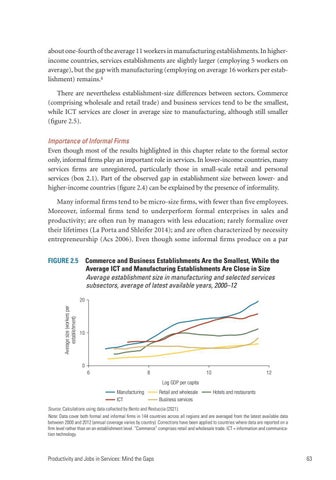about one-fourth of the average 11 workers in manufacturing establishments. In higherincome countries, services establishments are slightly larger (employing 5 workers on average), but the gap with manufacturing (employing on average 16 workers per establishment) remains.4 There are nevertheless establishment-size differences between sectors. Commerce (comprising wholesale and retail trade) and business services tend to be the smallest, while ICT services are closer in average size to manufacturing, although still smaller (figure 2.5). Importance of Informal Firms Even though most of the results highlighted in this chapter relate to the formal sector only, informal firms play an important role in services. In lower-income countries, many services firms are unregistered, particularly those in small-scale retail and personal services (box 2.1). Part of the observed gap in establishment size between lower- and higher-income countries (figure 2.4) can be explained by the presence of informality. Many informal firms tend to be micro-size firms, with fewer than five employees. Moreover, informal firms tend to underperform formal enterprises in sales and productivity; are often run by managers with less education; rarely formalize over their lifetimes (La Porta and Shleifer 2014); and are often characterized by necessity entrepreneurship (Acs 2006). Even though some informal firms produce on a par FIGURE 2.5 Commerce and Business Establishments Are the Smallest, While the Average ICT and Manufacturing Establishments Are Close in Size Average establishment size in manufacturing and selected services subsectors, average of latest available years, 2000–12 Average size (workers per establishment)
20
10
0 6
8
10
12
Log GDP per capita Manufacturing ICT
Retail and wholesale Business services
Hotels and restaurants
Source: Calculations using data collected by Bento and Restuccia (2021). Note: Data cover both formal and informal firms in 144 countries across all regions and are averaged from the latest available data between 2000 and 2012 (annual coverage varies by country). Corrections have been applied to countries where data are reported on a firm level rather than on an establishment level. “Commerce” comprises retail and wholesale trade. ICT = information and communication technology.
Productivity and Jobs in Services: Mind the Gaps
63

